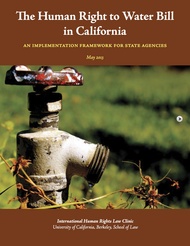
A new report by the International Human Rights Law Clinic (IHRLC) provides a road map for the implementation of California’s Human Right to Water bill, AB 685. The act, signed by Governor Jerry Brown last September, aims to ensure universal access to safe, clean, and affordable water. It makes California the nation’s first state to explicitly recognize the human right to water.
Entitled “The Human Right to Water Bill in California: An Implementation Framework for State Agencies,” the report draws on domestic and international law to guide regulators. Berkeley Law students Angélica Salceda ’13, Christine Zülow LL.M. ’13, and Kimya Saied ’14 co-authored the report under the supervision of IHRLC Associate Director Roxanna Altholz ’99 and Clinical Instructor Allison Davenport ’04.
Twenty-one million Californians lack access to safe and affordable drinking water, according to a draft 2012 report by the State Water Resources Control Board. Many of these residents live in low-income and marginalized communities with aging, dilapidated water pipes that pump groundwater contaminated with nitrates and other toxins into homes and schools.
“The lack of access to clean water in California has serious health and financial consequences that disproportionately impact low-income communities of color,” said Altholz. “AB 685 requires state agencies to address the human costs of unsafe water.” She added that the bill places the human right to water at the center of state policy and underscores the crucial role of state agencies in improving access by underserved communities.
On June 6 in Sacramento, Altholz and Davenport gave a presentation to legislative and agency staff, among other state officials, regarding IHRLC’s framework for implementing the bill. They outlined the general responsibilities of relevant agencies, and how international human rights law could inform and shape implementation efforts. Later this month, Altholz and Davenport will meet with Governor Brown’s interagency task force on water management.
The clinic report describes how state agencies can best address water challenges affecting diverse populations living in urban, tribal, rural, and unincorporated communities. “Residents living in disadvantaged communities navigate endless water politics and barriers in an effort to access clean drinking water,” said Salceda. “Our report provides a road map for breaking down those barriers and advancing the human right to water for all Californians.”
The report also calls on the governor’s office to issue agency-specific guidance that ensures “an effective and coordinated approach” to implementation.
“AB 685 provides the opportunity to move beyond the convoluted and opaque system that currently exists,” Davenport said, “and to put in place a comprehensive and common-sense approach to water quality and affordability issues in the state.”
IHRLC recommends that state agencies look to the international definition of the human right to water to establish clear policy objectives and help provide all Californians with enough safe, acceptable, and affordable water. “Under international standards, the cost of clean water should not exceed 3 to 5 percent of household income,” Zülow said. “But in some California communities with contaminated water, residents spend 20 percent of a median annual income of $14,000 to pay their water bill and purchase bottled water.”
The report also identifies human rights principles—such as non-discrimination, public participation, and accountability—that could guide agency implementation efforts and foster good governance. A central theme of the report is the importance of meaningful participation by impacted community members in agency decision-making.
“All too often, the communities facing the most serious water problems are not at the table when decisions affecting them are made,” Saied noted. “As a result, real solutions are never reached and the problems persist or even worsen.” The report proposes that agencies produce multi-lingual materials, provide timely water quality data to the public, and facilitate citizen input in water governance decisions.
“The recommendations in the report are the starting point and not the end itself,” Salceda said. “The state should continue to push for policies that prioritize communities that lack safe water and ensure their vigorous implementation.”